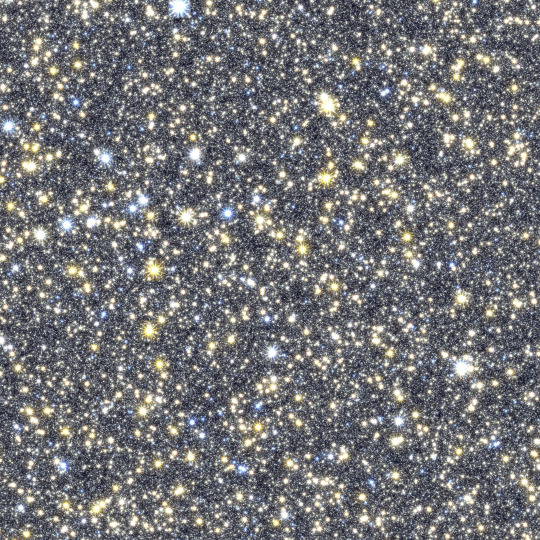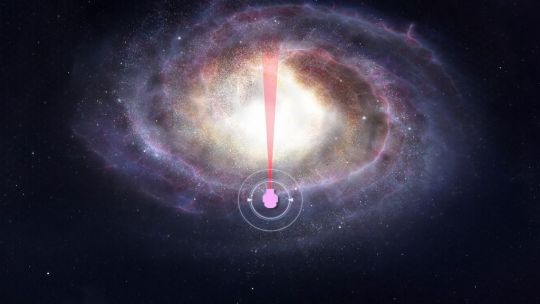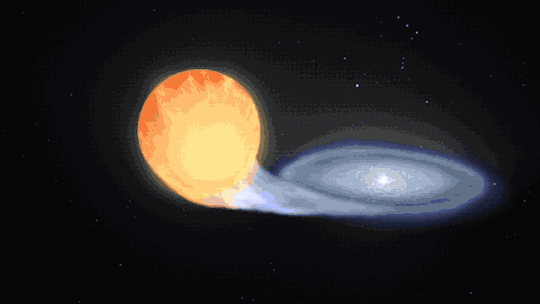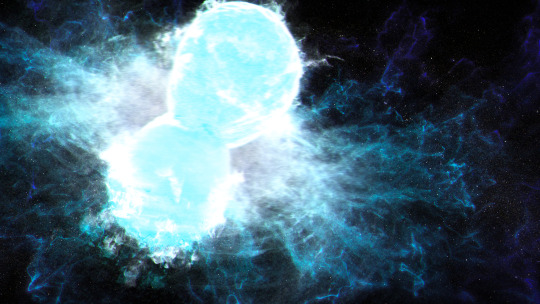#kilonovae
Explore tagged Tumblr posts
Text
I need people to understand that Uranium is an eldritch horror
I'm not talking about radiation, or nuclear weapons, or anything that you can do with uranium, I mean its mere existence on Earth is a reminder of cosmic horrors on a scale you can barely conceive of.
When a nuclear power plant uses Uranium to boil water and spin steam turbines to keep the lights on, they're unleashing the fossilized energy of the destroyed heart of an undead star.
Allow me to elaborate:
In the beginning, there were hydrogen and helium. The primordial fires of the Big Bang produced almost exclusively the two lightest elements, along with a minuscule trace of lithium. It was a start, but that's not much to build a universe out of. Fortunately, the universe is full of element factories. We call them "stars".
Stars are powered by nuclear fusion, smooshing light elements together to make heavier elements, and releasing tremendous amounts of energy in the process, powering the star and making it shine. This goes on for millions to billions of years depending on the stars mass (although not how you might think, the bigger stars die young), the vast majority of that time spent fusing hydrogen into yet more helium. Eventually, the hydrogen in the core starts to run low, and if the star is massive enough it starts to fuse helium into carbon, then oxygen, neon, and so on up through successively heavier elements.
There's a limit to this though:

This chart shows how much energy is released if you were to create a given element/isotope out of the raw protons and neutrons that make it up, the Nuclear Binding Energy. Like in everyday life, rolling downhill on this chart releases energy. So, starting from hydrogen on the far left you can rapidly drop down to helium-4 releasing a ton of energy, and then from there to carbon-12 releasing a fair bit more.
But, at the bottom of this curve is iron-56, the most stable isotope. This is the most efficient way to pack protons and neutrons together, and forming it releases some energy. But once its formed, that's it. You're done. Its already the most stable, you can't get any more energy out of it, and in fact if you want to do anything to it and make it into a different element you're going to have to put energy in.
So, when a massive star's core starts to fill up with iron, the star is doomed. Iron is like ash from the nuclear fire that powers stars, its what's leftover when all the fuel is used up. When this happens, the core of the star isn't producing energy and can't support itself anymore and catastrophically collapses, triggering a supernova explosion which heralds the death of the star.
What kind of stellar-corpse gets left behind depends again on how massive the star is. If its really big, more than ~30 times the mass of the sun and its probably going to form a black hole and whatever was in there is gone for good. But if the star is a bit less massive, between 8-25 solar masses, it leaves behind a marginally less-destroyed corpse.
The immense weight of the outer layers of the star falling down on the core compresses the electrons of the atoms into their nuclei, resulting in them reacting with protons and turning them all into neutrons, which creates a big ball of almost pure neutrons a couple miles across, but containing the entire mass of the star's core, 3-5 sun's worth.
This is the undead heart of the former star: a neutron star.
If, like many stars, this one wasn't alone but had a sibling, it can end up with two neuron stars orbiting each other, like a pair of zombies acting out their former lives. If they get close enough together, their intense gravity warps the fabric of spacetime as they orbit, radiating away their orbital energy as gravitational waves, slowing them down and bringing them closer together until they eventually collide.
The resulting kilonova explosion destroys both of the neutron stars, most likely rendering the majority of what's left into a black hole, but not before throwing out a massive cloud of neutron-rich shrapnel. This elder-god blood-splatter from the collision of the undead hearts of former stars contains massive nuclei with hundreds to thousands of neutrons, the vast majority of which are heinously unstable and decay away in milliseconds or less. Most of their decay products are also unstable and decay quickly as well, eventually falling apart into small enough clusters to be stable and drift off into the universe becoming part of the cosmic dust between the stars.
However,
Some of the resulting massive elements are merely almost stable. They would like to decay, but for quantum-physics reasons decaying is hard and slow for them, so they stick around much longer than you might expect. Uranium is one such element, with U-238 having a half-life of around 4.5 billion years, about the same as the age of the Earth, and its spicier cousin U-235 which still has a respectable 200 million year half life.
These almost-stable isotopes were only able to be created in the fiery excess of energy in a neutron star collision, and are the only ones that stick around long enough to carry a fraction of that energy to the era where hairless apes could figure out that a particular black rock made of them was emitting some kind of invisible energy.
So as I said at the beginning, Uranium is significant because it stores the fossilized energy of the destroyed heart of an undead star, and we can release that energy at will if we set it up just right.
When you say it like that, is it any shock that the energy in question will melt your face off and rot your bones from the inside if you stay near it too long?
#nuclear physics#nucleosynthesis#stellar nucleosynthesis#neutron star#uranium#radiation#supernova#kilonova#cosmic horror#physics#science#space#astrophysics#stars#stellar evolution
1K notes
·
View notes
Text

A simulated image of NASA’s Nancy Grace Roman Space Telescope’s future observations toward the center of our galaxy, spanning less than 1 percent of the total area of Roman’s Galactic Bulge Time-Domain Survey. The simulated stars were drawn from the Besançon Galactic Model.
Exploring the Changing Universe with the Roman Space Telescope
The view from your backyard might paint the universe as an unchanging realm, where only twinkling stars and nearby objects, like satellites and meteors, stray from the apparent constancy. But stargazing through NASA’s upcoming Nancy Grace Roman Space Telescope will offer a front row seat to a dazzling display of cosmic fireworks sparkling across the sky.
Roman will view extremely faint infrared light, which has longer wavelengths than our eyes can see. Two of the mission’s core observing programs will monitor specific patches of the sky. Stitching the results together like stop-motion animation will create movies that reveal changing objects and fleeting events that would otherwise be hidden from our view.
youtube
Watch this video to learn about time-domain astronomy and how time will be a key element in NASA’s Nancy Grace Roman Space Telescope’s galactic bulge survey. Credit: NASA’s Goddard Space Flight Center
This type of science, called time-domain astronomy, is difficult for telescopes that have smaller views of space. Roman’s large field of view will help us see huge swaths of the universe. Instead of always looking at specific things and events astronomers have already identified, Roman will be able to repeatedly observe large areas of the sky to catch phenomena scientists can't predict. Then astronomers can find things no one knew were there!
One of Roman’s main surveys, the Galactic Bulge Time-Domain Survey, will monitor hundreds of millions of stars toward the center of our Milky Way galaxy. Astronomers will see many of the stars appear to flash or flicker over time.
youtube
This animation illustrates the concept of gravitational microlensing. When one star in the sky appears to pass nearly in front of another, the light rays of the background source star are bent due to the warped space-time around the foreground star. The closer star is then a virtual magnifying glass, amplifying the brightness of the background source star, so we refer to the foreground star as the lens star. If the lens star harbors a planetary system, then those planets can also act as lenses, each one producing a short change in the brightness of the source. Thus, we discover the presence of each exoplanet, and measure its mass and how far it is from its star. Credit: NASA's Goddard Space Flight Center Conceptual Image Lab
That can happen when something like a star or planet moves in front of a background star from our point of view. Because anything with mass warps the fabric of space-time, light from the distant star bends around the nearer object as it passes by. That makes the nearer object act as a natural magnifying glass, creating a temporary spike in the brightness of the background star’s light. That signal lets astronomers know there’s an intervening object, even if they can’t see it directly.

This artist’s concept shows the region of the Milky Way NASA’s Nancy Grace Roman Space Telescope’s Galactic Bulge Time-Domain Survey will cover – relatively uncharted territory when it comes to planet-finding. That’s important because the way planets form and evolve may be different depending on where in the galaxy they’re located. Our solar system is situated near the outskirts of the Milky Way, about halfway out on one of the galaxy’s spiral arms. A recent Kepler Space Telescope study showed that stars on the fringes of the Milky Way possess fewer of the most common planet types that have been detected so far. Roman will search in the opposite direction, toward the center of the galaxy, and could find differences in that galactic neighborhood, too.
Using this method, called microlensing, Roman will likely set a new record for the farthest-known exoplanet. That would offer a glimpse of a different galactic neighborhood that could be home to worlds quite unlike the more than 5,500 that are currently known. Roman’s microlensing observations will also find starless planets, black holes, neutron stars, and more!
youtube
This animation shows a planet crossing in front of, or transiting, its host star and the corresponding light curve astronomers would see. Using this technique, scientists anticipate NASA’s Nancy Grace Roman Space Telescope could find 100,000 new worlds. Credit: NASA’s Goddard Space Flight Center/Chris Smith (USRA/GESTAR)
Stars Roman sees may also appear to flicker when a planet crosses in front of, or transits, its host star as it orbits. Roman could find 100,000 planets this way! Small icy objects that haunt the outskirts of our own solar system, known as Kuiper belt objects, may occasionally pass in front of faraway stars Roman sees, too. Astronomers will be able to see how much water the Kuiper belt objects have because the ice absorbs specific wavelengths of infrared light, providing a “fingerprint” of its presence. This will give us a window into our solar system’s early days.

This animation visualizes a type Ia supernova.
Roman’s High Latitude Time-Domain Survey will look beyond our galaxy to hunt for type Ia supernovas. These exploding stars originate from some binary star systems that contain at least one white dwarf – the small, hot core remnant of a Sun-like star. In some cases, the dwarf may siphon material from its companion. This triggers a runaway reaction that ultimately detonates the thief once it reaches a specific point where it has gained so much mass that it becomes unstable.
youtube
NASA’s upcoming Nancy Grace Roman Space Telescope will see thousands of exploding stars called supernovae across vast stretches of time and space. Using these observations, astronomers aim to shine a light on several cosmic mysteries, providing a window onto the universe’s distant past. Credit: NASA’s Goddard Space Flight Center
Since these rare explosions each peak at a similar, known intrinsic brightness, astronomers can use them to determine how far away they are by simply measuring how bright they appear. Astronomers will use Roman to study the light of these supernovas to find out how quickly they appear to be moving away from us.
By comparing how fast they’re receding at different distances, scientists can trace cosmic expansion over time. This will help us understand whether and how dark energy – the unexplained pressure thought to speed up the universe’s expansion – has changed throughout the history of the universe.

NASA’s Nancy Grace Roman Space Telescope will survey the same areas of the sky every few days. Researchers will mine this data to identify kilonovas – explosions that happen when two neutron stars or a neutron star and a black hole collide and merge. When these collisions happen, a fraction of the resulting debris is ejected as jets, which move near the speed of light. The remaining debris produces hot, glowing, neutron-rich clouds that forge heavy elements, like gold and platinum. Roman’s extensive data will help astronomers better identify how often these events occur, how much energy they give off, and how near or far they are.
And since this survey will repeatedly observe the same large vista of space, scientists will also see sporadic events like neutron stars colliding and stars being swept into black holes. Roman could even find new types of objects and events that astronomers have never seen before!
Learn more about the exciting science Roman will investigate on X and Facebook.
Make sure to follow us on Tumblr for your regular dose of space!
#NASA#astronomy#telescope#Roman Space Telescope#dark energy#galaxies#cosmology#astrophysics#stars#galaxy#space images#time#supernova#Nancy Grace Roman#black holes#neutron stars#kilonova#rogue planets#exoplanets#space#science#tech#technology#Youtube
3K notes
·
View notes
Text
My game!!! <- that’s a link to the trailer
Is going up on STEAM!!
May 17th!!!
Kilonova is coming!
^Thats a link to the steam page
287 notes
·
View notes
Text
I turned @mac-and-thefox ‘s req into a coloured drawing. Shhhhhhh they sleeping

I won’t make excuses about how I have a blinding headache and can’t see straight. I won’t. Okay I did. Sorry.
#rain ghoul#dewdrop ghoul#midnight moth draws#the band ghost fanart#nameless ghouls#the band ghost#nameless ghouls fanart#yes it’s kilonova rain and dew
101 notes
·
View notes
Text
Hehoo

It’s been a minute since I've been fully active here and decided to pop over to my favorite blog for a bit
Bought a new reference photo pack and saw one that felt appropriate, so have some SC Sun and Comet warm up sketching
(Hi @8um8le ;3)

Comet the anxious wet cat is my favorite gender 😂 drawing him next to Nova is absolutely wild stylistically but I think if they were to talk about the restaurant business Comet might open up a lil bit (or get his retail face activated)
47 notes
·
View notes
Text





i appear once in a blue moon. this time to hand you all mouthwashing doodles since i am hyperfixated (featuring some doodles and comments from a friend who knows nothing about it)

@dantezdoodlez
#BTW THERE IS NO SHIPPING IN THIS POST I DO NOT SHIP ANY PEOPLE IN MOUTHWASHING. i don't want the matching earrings to be seen as that#i hate jimmy#he's a good antagonist though#our art#kilonova collections#mouthwashing#curly mouthwashing#anya mouthwashing#jimmy mouthwashing#mouthwashing game#mouthwashing fanart#mouthwashing art
25 notes
·
View notes
Text
Screw it, I'm starting a fanfiction cooking series.
Yeah so this got slightly out of hand. I recently re-(re-re-re)read @midnight-moth's masterpiece that is Kilonova and I was probably hungry while at chapter 28/29, because chickpeas have been on my mind ever since (it's been weeks y'all). So may I present my most unhinged and obsessive fandom thing yet: RainDrop's chickpea flatbreads.
There was some kind of sandwich wrapped in flat bread that only had vegetables and chickpeas in it and a sauce that tasted like garlic and basil.
Also can I just say the chapter description "Rain likes Chickpeas. Dewdrop is sweaty." is a hilariously accurate description of this whole stage of their relationship. So adorably enamored by everything the other does. As Moth's Dew says: Death, he was I am in fact dead now.


A N Y W A Y, while I may not have a 1000-years-old-but-also-childishly-naïve water ghoul to trill at me (cute; death.) and demand individual chickpea feeding, I can see why Rain liked this. Maybe if I'm bored I'll type up a recipe (I am Not A Good Cook, this was not difficult lol).
This was fun, and made me not eat oven pizza yet again, please feel free to share other fandom foods with me to feed (literally) my hyperfixation!
#how tf should I tag this...?#midnight_moth's Kilonova#em cooks#fandom cooking#ghost#raindrop#this made me clean my kitchen (all 20cm of it!). now how can I use fandom to trick myself into cleaning the rest of my flat?#and yes that is a bunch of electrical cables centimeters from my hob. safety first here in germany!#ghost fandom cooking
57 notes
·
View notes
Text
Fashion Week

Sort of breaking standard rotation with this since it started with Ty and ended with Event, but I finally got the boys to all have some kind of values-and-wardrobe page to experiment with their looks a little bit. I’m sure I’ve shown the others off at some point but it’s nice to have everyone together on the same page too~



#fashion#sketches#Azil#free runner AU#free runner event#echo chamber#free runner eclipse#event horizon#tydal locke#kilonova
12 notes
·
View notes
Text
Supernovae are some of the most powerful explosions in the Universe, occurring in the final death throes of massive stars.
#my writing#supernova#hypernova#kilonova#astroblr#astrophotography#astronomy#astronomia#astrophysics#physics#women in stem#astro observations#science#space
24 notes
·
View notes
Text
the day i write a fic with food which results in that food being incorporated into @cheerycherrycandy-resurrected’s ghost fandom cooking saga is the day i’ll know i have succeeded in life skdhfhjddj
12 notes
·
View notes
Text

Avery’s fancy new digs for The Kilonova Effect AU with @krokaxe
#favorite piece of art of him I’ve made in a hot lil minute. he so shiny#now to finish owain and mournes fit refs#autumn art#avery#the kilonova effect#oc#oc artist#scifi
71 notes
·
View notes
Text
The long awaited trailer to Kilonova is here! I've been working on this project since fall of last year, and with a team of 20 other students we've brought it to life!
I did the creature designs for two of the enemies, Stellupi and Eversor, created all the rigs, did some proxy models and modeled the collars and stars inside them. I was also the lead animator and did many of the creature animations, especially the ones shown here in the trailer! I also provided the sounds for the stellupi which you can hear a little of in the trailer.
This past semester I stepped into the role of art director and I'm absolutely ecstatic about what our team managed to put together. Kilonova will be coming to Steam sometime next year, and I couldn't be more proud to have been part of this project.
616 notes
·
View notes
Text
I decided to paint kilonova Dew cause why not

#why does it look like crap on here#oh well#midnight moth draws#the band ghost fanart#nameless ghouls#dewdrop ghoul#kilonova
107 notes
·
View notes
Text
Well someone managed to push his buttons

A little different from the Moon one, which was mostly shadow, but I still think it turned out pretty neat. If anything, it was good practice as drawing fire (though I compensated with a fire brush I had to make the contrast higher) and honestly, I'm living for the scarf fluttering.
Fic link:
#security breach au#robot#fnaf oc#azil#sundrop#supernova#azil sun#free runner au#pyrokinetic#flames#seriously what did you do#this guy never gets mad#what#kilonova#azil nova#free runner nova#sunn
14 notes
·
View notes
Text


tried to draw them for the first time :) happier with the viktor drawing.. jayce needs some more drawings so i can get him right
#arcane#arcane fanart#viktor arcane#viktor arcane fanart#viktor fanart#jayce fanart#jayce talis fanart#arcane jayce#arcane viktor#jayce. jaybe or... jaybe not?#our art#kilonova collections
21 notes
·
View notes
Text
i wasnt feeling the greif [sic] album when it came out tbh but its growing on me
#i think i was looking for something heavier at the time so i was a bit disappointed#but relistening to it now. yea its good LMAO#also the kilonova mv coming out and totally recontextualising the other videos!!!!!
4 notes
·
View notes